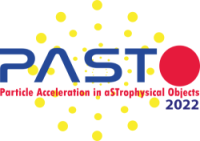Speaker
Description
Cosmic ray driven instabilities play a crucial role during particle acceleration at shocks and during the propagation of the accelerated cosmic rays in astrophysical systems. The instabilities amplify magnetic fields and modulate cosmic ray transport so that the intrinsically collisionless cosmic ray population is coupled to the thermal plasma and provides important dynamical feedback. We found a new cosmic ray driven instability (called intermediate-scale instability) that excites comoving ion-cyclotron electromagnetic waves at sub-ion skin-depth scale. The instability operates if cosmic rays with a finite pitch angle drift with moderately super-Alfvénic speeds. Its linear growth rate is typically about 100 times faster in comparison to that at the ion gyro-scale, making it a crucial player in both acceleration and transport of charged particles in galactic and stellar environments. I will demonstrate that that this new instability provides the only known mechanism to date for efficient electron acceleration at parallel electron-ion shocks, thus solving the long-standing electron-injection problem at these shocks. We apply this physics to 3D magnetohydrodynamics simulations of the evolution of an entire supernova remnant, where we self-consistently include cosmic ray protons and follow the time evolution of the cosmic ray electron spectrum. By matching the observed morphology and non-thermal spectra of shell-type supernova remnants (SN 1006, RXJ 1713, and Vela Jr.) in radio, X-rays and gamma-rays, I demonstrate how we gain insight into the following topics: 1) leptonic vs. hadronic model of the gamma-ray emission, 2) origin of patchiness of TeV gamma-ray maps and how this relates to interstellar magnetic turbulence, 3) quasi-parallel vs. quasi-perpendicular acceleration of cosmic ray electrons, 4) nature of magnetic field amplification and damping in supernova remnants (turbulently vs. Bell-amplified magnetic field).

